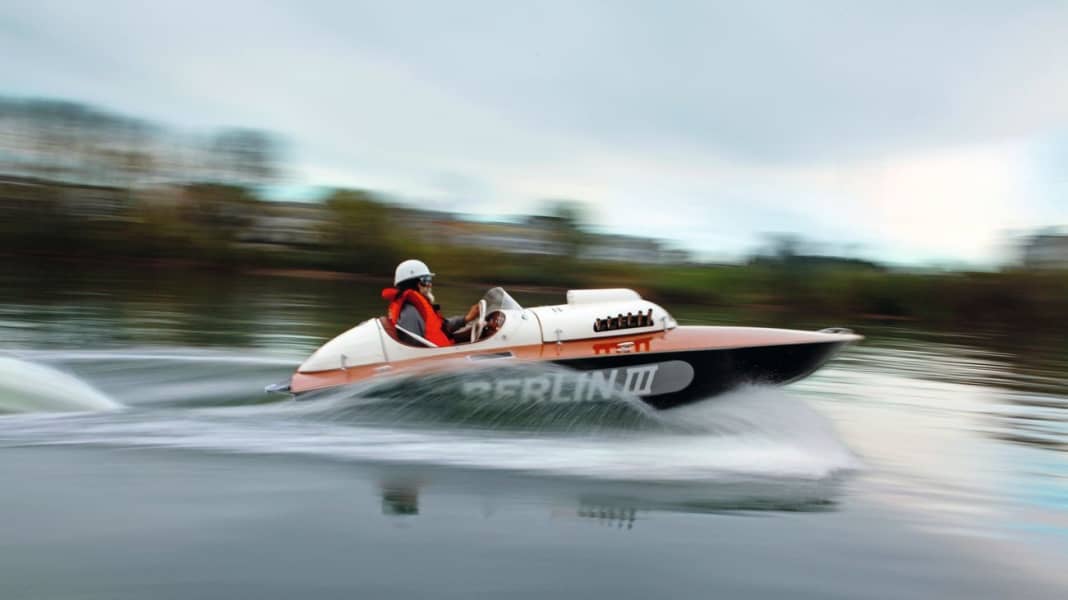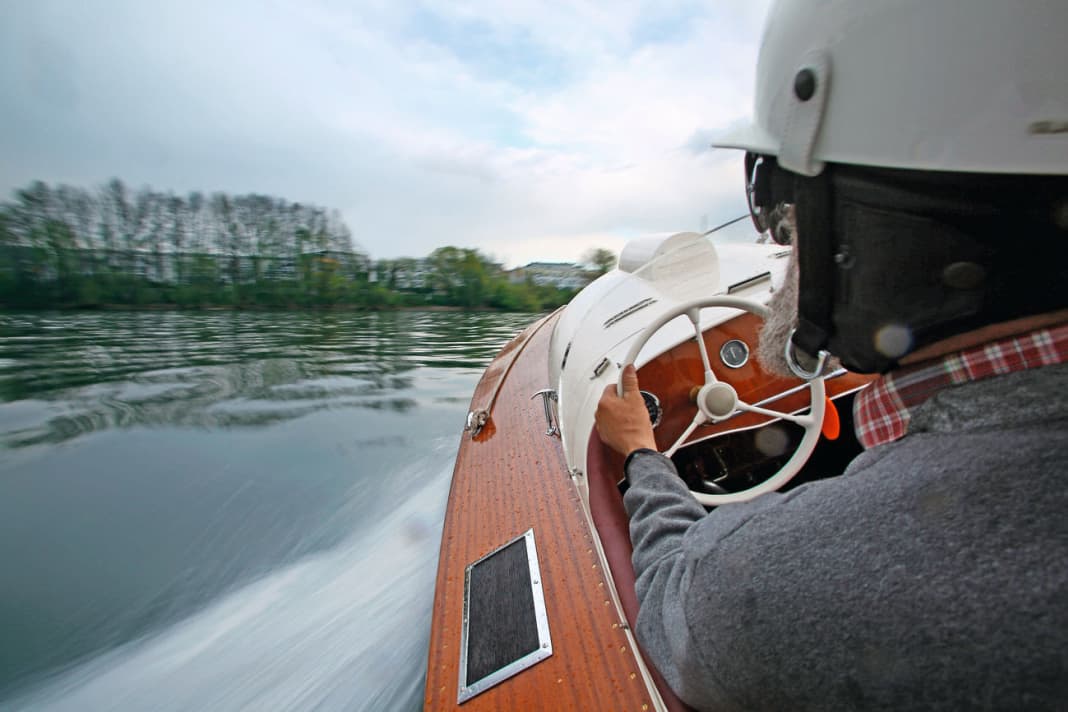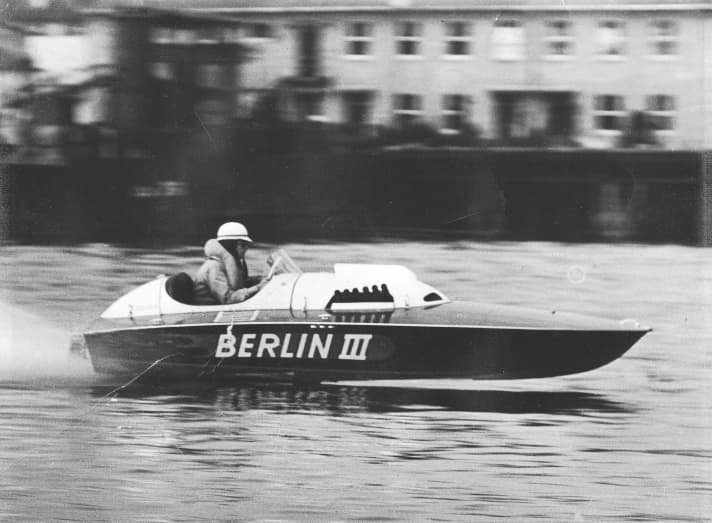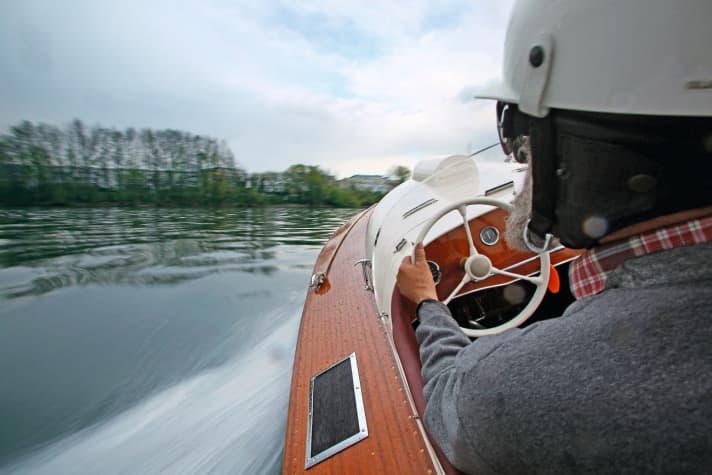
When shipyard owner Rolf Gersch followed a tip from a customer in 2003 and entered a backyard near Mainz, he didn't realise what a treasure lay before him. The outer skin of the old wooden boat was torn open, parts of the structure were rotten and the engine was missing; other important components such as the stern pulpit, on which an original BMW logo was still emblazoned, had been preserved.
Gersch, who "somehow recognised" the wreck, bought it for a modest price. At home, he was quickly able to identify it from old photos: He had rediscovered the long-lost "Berlin III".
The "Berlin III" is not just any old racing boat. To understand its significance, you have to go back a few decades in the history of boating. In the early 1950s - less than ten years after the Second World War - only a small, wealthy elite could afford a racing boat.






It included the young Jürgen Baginski as well as his compatriot Christoph von Mayenburg, who was already internationally recognised. Because the Baginski family produced painkillers and von Mayenburg's Chlorodont toothpaste - both mass-produced goods - they escaped the economic hardships of the post-war period faster than many others.
In 1950, von Mayenburg introduced his friend to Max Steaves, who owned the shipyard of the same name in Wiesbaden. The ship designer built several successful racing boats and is also the father of the "Berlin III". As was customary in Europe at the time, he orientated himself on models that were classified as "D-class racing boats" by the American Powerboat Federation.
On the advice of his friend Christoph von Mayenburg, Jürgen Baginski placed the "Berlin III" in the care of Rolf Gersch's father Kurt - a talented boat builder from Wiesbaden who also raced - for maintenance and tuning.
Baginski's remarkable racing career began at the helm of the "Berlin III" in the early fifties. He was not yet very successful with his first boat and mainly won regional competitions, such as the race on Lake Starnberg in 1953.
But from the mid-fifties onwards, Baginski had new models produced, all of which were christened "Berlin" (a reminiscence of the capital city where his father Maximilian's successful business career once began) and were strictly numbered.
Just a few years later, in 1956, he won several international races with a successor boat called "Berlin VI" - built by Kurt Gersch, who was on board as co-pilot - and finally won the world championship title in Cannes.

The "Berlin III" had long since been scrapped and was well on its way to being forgotten...
Bayerische Motoren Werke: A young company in the fast lane
The boat was also special in another respect. While Italian boat builders had frequently equipped their racing boats with engines from their best racing cars since the 1950s, such models were rare in Germany.
But the "Berlin III" is just such a case. Here, German boatbuilding expertise and cutting-edge drive technology from BMW were successfully combined. For this, we have to delve a little deeper into history - all the way back to the 1930s.
BMW was still a relatively young car manufacturer at the time. It had only been producing its own models for five years. The Bavarian company, which had emerged from the Rapp Motoren Werke, among others, built aeroplane engines and began producing motorbikes in 1923.
For the first time, they bore the famous BMW logo, which is often interpreted as rotor blades against a blue sky. In fact, they had only adopted the old Rapp logo and replaced the horse in the black circle with the Bavarian national colours of blue and white.
Due to the economic crisis in the early 1930s, money was tight and the engineers had to outdo each other to find efficient and cost-effective solutions. In addition, quick racing successes were needed to hold their own against the Italian and British competition.
The 328 Roadster was launched in 1936. The magazine "Motor und Sport" praised the model because it combined the durability and ease of servicing of a passenger car with the potential of a racing car. There is no better way to describe why the new BMW gained its enviable reputation so quickly, even beyond the country's borders.

The 328 was based on earlier models, but the engineering team had achieved a breakthrough in terms of lightness and speed. Among the talented engineers and designers who made the BMW brand famous, Fritz Fiedler, who was responsible for the development of new models, was one of the most important. One of his closest and best colleagues was the former motorbike racer Rudolf Schleicher, who also took over the management of the racing department at the end of the 1930s.
Two other key figures, Peter Szymanowski and Wilhelm Meyerhuber, came from the body shop. Chief designer Szymanowski was a pioneer; he was one of the first to use extensive tests in the wind tunnel. Meyerhuber was responsible for the legendary prototype of the 328 Mille Miglia Roadster. And another man played an important role, even if he was not permanently employed by BMW: Wunibald Kamm, also a pioneer in the field of aerodynamics.

The body of the 328 was based on that of the 319/1 model; however, the headlights had been redesigned and the bonnet significantly extended. Its unmistakable hallmark: the two leather straps with which it was fixed. The BMW 328 was only available as a roadster; however, almost sixty chassis were sold to various coachbuilders. From the middle of 1936, the car was mainly built for racing purposes and went into series production in the spring of 1937.
There was no money for the construction of a DOHC engine with two overhead camshafts, so Fiedler designed a new aluminium cylinder head with a mechanically complex valve control system for the old two-litre engine. As a result, the engine produced 80 hp in the car, which weighed just 830 kilograms - a technical masterpiece for the year 1936.
Fiedler's six-cylinder engine with a new head was indeed ideally suited to motorsport - the racing versions, such as the version initially known as the "Mille Miglia", delivered 135 hp and more on the road. No wonder that the BMW Roadster - having already won a test drive on the Nürburgring - won one prize after another.
In 1937, Prince Bira won the Tourist Trophy in the two-litre class at Donington Park and finished third in the overall standings. At the 1938 German Grand Prix, the BMW 328 dominated the two-litre class at will. It also built its legendary reputation on top placings in Italian races, the Mille Miglia of 1938 and 1940, and in the 24 Hours of Le Mans in 1938 and 1939.
The successful BMW engines also set standards in the post-war period
Even in the years after the end of the Second World War, BMW was able to continue this impressive series - even though the company was cannibalised by the Western Allies during this period and the most important car factory in Eisenach was located in the Soviet occupation zone.
During this difficult phase, both the cars and the engines bore different company logos. Fritz Fiedler, for example, was sent to England in 1945 to help produce the Bristol 400, which was directly derived from the BMW 327. BMW models (later called EMW) were also produced at the Eisenach plant in the later GDR from 1945 onwards.
In the West, former BMW employees founded the company BMW Veritas; the company, which focussed more on motorsport, tuned 328 models from the pre-war period. In 1947, Karl Kling triumphed on the Hockenheim Ring and later became the first German champion in the two-litre class in a Veritas.
After more than sixty years, a special kind of veterans' reunion takes place
The Veritas company also produced some marinised versions of the 328 six-cylinder engine; the light and powerful engine was also of interest to the few German racing boat drivers that existed at the time. This is how the fast, excellently designed hull of the "Berlin III" came to be equipped with such an engine trimmed for maximum performance.
Rolf Gersch was looking for a suitable party to restore his spectacular find. With the support of master carpenter Sven Hageborg, Torsten Müller, an entrepreneur from northern Germany, tackled the restoration. It took around 2500 hours of labour to restore the lightly built hull with oak and cedar frames and the outer skin made of mahogany plywood. The famous six-cylinder engine, a BMW Veritas from the late 1940s, was patiently tuned to the racing version and installed.
Around 60 years ago, Kurt Gersch sat at the helm of the "Berlin III" for the last time. In April 2016, she took to the water again at Rolf Gersch's marina on the Rhine and presented herself as elegantly as in her best days. One guest of honour was not to be missed: a BMW 328 Roadster, built at the end of 1937, from the collection of well-known BMW restorer Thomas Feierabend.
Like the boat, the car has an eventful history: the chassis with the number 85053 dates back to the first series production. The well-known BMW works driver Adolf Brudes once sat at the wheel of the racing car, finishing fourth overall in the Spa 24-hour race in 1938 with his team-mate Paul Heinemann.
Thomas Feierabend's father Helmut had discovered the car 25 years earlier in Budapest. It was completely restored in the family workshop, including the engine in the original Mille Miglia version with more than 135 hp. Just as the BMW engineers and designers envisioned at the time, the white roadster from 1937 has once again become a reliable and elegant sports car that reaches speeds of up to 200 km/h and can therefore hold its own on the racetrack at any time.
The boat and the BMW: a dream team. Who would think that Bavaria and Berlin don't get along?
A hobby for the wealthy
The story of the "Berlin III" also tells of the beginnings of motorboat racing in the Federal Republic of Germany after the Second World War - at the time a "sophisticated" leisure activity for a privileged few. Like Christoph von Mayenburg with his "Mathea" racing boats, Jürgen Baginski was only able to finance the "Berlin" models because his father Maximilian had built up a successful health company in Berlin at the beginning of the 20th century - among other things, he invented various massage devices and the famous splitting tablet. After the end of the war, most of the production facilities were located in the Soviet occupation zone. Maximilian Baginski was sentenced to prison under the communists. As his patents and registered trade marks were still valid in the West, he was able to quickly resume his entrepreneurial success after his release in 1948. He retired in 1964. Jürgen Baginski took over the management of the company until it was sold in the 1970s.

